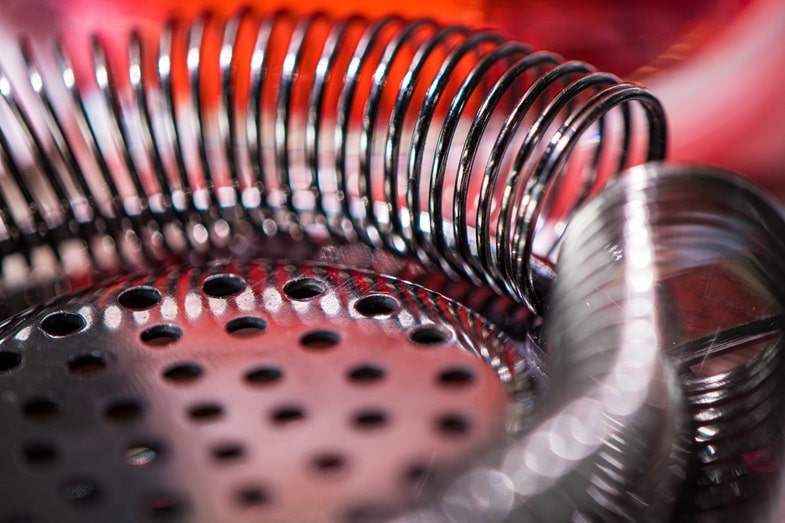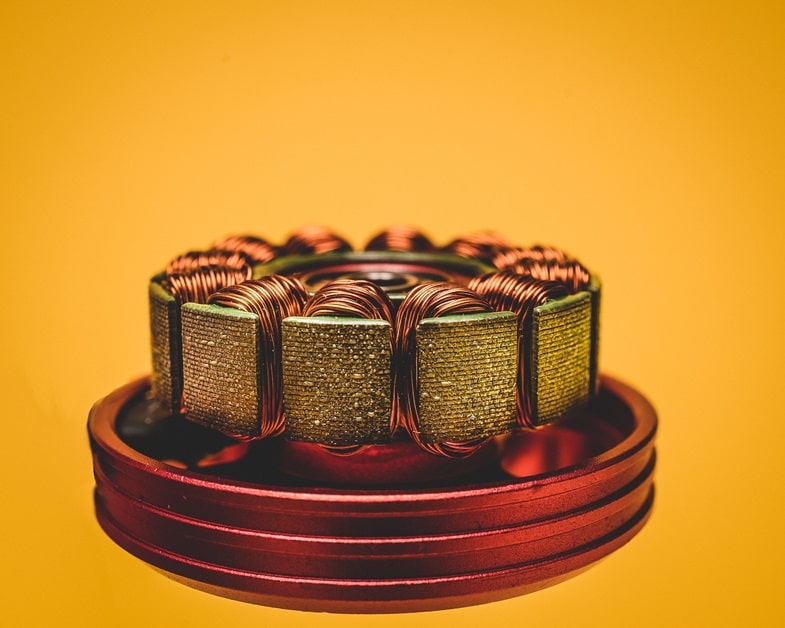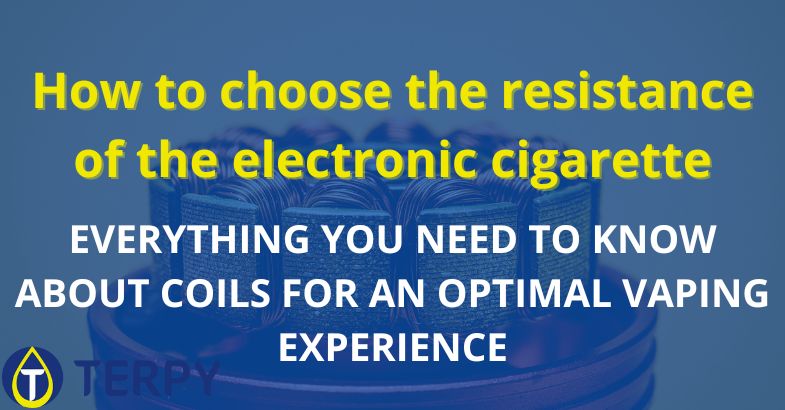Published on: 21/01/2024
EVERYTHING YOU NEED TO KNOW ABOUT COILS FOR AN OPTIMAL VAPING EXPERIENCE
Are you a fan of the world of electronic cigarettes and often find yourself wondering which coil is the best choice to achieve your ideal vaping experience?
Well, know that you are not alone. Navigating the sea of resistance options may seem complicated, but there are some fundamental keys to understanding this universe.
In this article, we will guide you through the essential concepts of Ohm’s law and how it affects the resistors for your e-cigarettes , then illustrating what other factors determine the performance of the coils and, consequently, guide the choice of the ideal one for you. From physics to practice, you’ll discover how to select the perfect resistance for your vape .Understand Ohm’s law that governs the operation of e-cigarette resistors
The first step in choosing the ideal resistance for your electronic cigarette is to understand what lies behind the concept of ohm .
To explain it, we need to brush up on some physics notions: in simple terms, it is the unit of measurement of resistance. The greater the resistance of an object (in this case the coil contained in the resistance of the e-cig), the lower the intensity of current that passes through it when the electronic cigarette is activated.
We are talking about a phenomenon described in mathematical terms by the so-called Ohm’s law :
I = V / R
Where ‘I’ represents the intensity of the current (measured in amperes), ‘V’ the voltage (measured in volts) and ‘R’ the resistance (measured, precisely, in ohms).
To give a real-world example, try to imagine cars on a road. The number of cars represents the intensity of the current while the width of the roadway represents, in an inverse proportion, the resistance. In other words, the higher the number of ohms the narrower the road and vice versa .
When the resistance is very high, the cars traveling will find themselves having to pass through a rather narrow roadway and will have to pass in a row one after the other. Conversely, when faced with a low number of ohms, vehicles will have a high number of lanes available and will be able to move much more quickly.
Read also: Smoking and electronic cigarette ban: a look at the Italian legislation


The impact of ohms on the vaping experience
Let’s now see how the ohms of a resistor influence in practical terms during vaping.
To put it simply, more heat is produced at low ohms, which affects vapor production, temperature, throat hit, and flavor. The opposite is true when it comes to vaping with a coil that has a high level of resistance.
At the experience level, the lowest ohms (especially in the sub-ohm range, i.e. below 1 ohm):
👉🏻they produce hotter vapor and in higher quantities;
👉🏻they drain the battery faster;
👉🏻they make the e-liquid consume a little faster, increasing the probability of a seizure if you vape compulsively.
On the other hand, the highest ohms :
👉🏻they produce colder vapor;
👉🏻they create less steam;
👉🏻they produce a smoother vape with less throat hit;
👉🏻they allow the battery to last longer between charges;
👉🏻they use less e-cig liquid .
Ohm and vaping in DTL/MTL
Based on the above-mentioned characteristics we can state that sub-ohm resistors are more suitable for DTL (direct to lung) vaping .
While this means that the battery consumes more energy , it also brings many advantages.
💡Great vapor production.
💡Wide airflow.
💡Dense vapor, also due to the fact that with DTL devices liquids with a higher concentration of vegetable glycerin are used.
Coils with a high ohm value, on the other hand, are more suitable for MTL vaping (mouth to lung): they have a lower power and are more recommended for those who want to experience a sensation very similar to that of cigarette smoking .
The vapor production of these devices is lower than DTL, but they offer the following advantages :
- cooler steam, because less heat is produced due to the lower intensity of the current;
- more genuine flavour;
- greater discretion;
- reduced consumption of e-cigarette liquid .
Head resistors vs regenerable resistors
Ohms are not the only distinguishing factor of e-cigarette resistors . The latter, in fact, can also be divided based on their nature between:
- head resistors;
- regenerable resistors.
The former are purchased ready to use and inserted directly into the atomizer, usually with a screw or interlocking system. They are the most common and the most recommended for beginners or for those who don’t want to waste too much time behind their device.
When shopping for coil resistors you are likely faced with three choices: standard, mesh or ceramic .
The former consist of a cotton wick inside which a metal wire is wound.
Mesh coils, on the other hand, are characterized by a plate with a mesh structure which guarantees:
- a more rapid increase in temperature;
- more steam and an intense flavor;
- often (but not always) a slightly shorter duration.
Regarding ceramic coils, keep in mind that there are two main styles :
- a coil – usually in kanthal – enclosed in a block of porous ceramic which simultaneously acts as a wick and protection;
- a coil coated in ceramic but which uses cotton as a wick.
This type has some advantages: first of all, it increases the duration of the resistance and protects it from burns due to dry firing. Secondly, it guarantees a superior quality aroma.
It doesn’t currently enjoy the same popularity as meshes, which is why it can be difficult to find parts compatible with your device.
How the material of the resistive wires affects the performance of regenerable resistors
Let’s now move on to the regenerable resistors that must be built by the vaper starting from the ‘raw materials’, i.e. cotton and resistive wires, or mesh.
They usually have the advantage of offering a more intense and genuine aroma than those with heads and are also very economical. However, they require some effort to build – a feature that could frustrate those who suddenly find themselves needing to change the resistance of their device without a lot of time at their disposal.
The resistive wires for rebuildable coils can be made of various metal alloys , each of which has very specific characteristics. The choice of one material rather than another is influenced by various aspects such as the type of e-cigarette liquid , the type of device, the type of shot, etc.
Among the most widespread alloys there are certainly Kanthal, Steel and Nichrome , which is an alloy made up of 80% Nickel and 20% Chromium. Resistive wires of this type are used with various wattages, especially in mechanical devices, and are suitable for both cheek and lung shooting.
Titanium, Nickel and Ni-Fe (Nickel and Iron) wires, on the other hand, are mainly used for cheek shooting and exclusively in electronic cigarettes that have the temperature control functionality .
But why does the metal material of which a coil is made make it better suited to a certain wattage and a certain type of e-cig and vape?
Well, because each alloy has a different reactivity and resistivity . Just as a diesel engine must be powered by diesel fuel, each e-cig needs a resistance suited to its technical characteristics.
But the material is not the only factor to take into consideration; there are, in fact, other characteristics of resistive wires that affect the vaping experience.
Read also: How to transport your electronic cigarette and vaping liquid safely


Other factors that influence the performance of regenerable resistors
The resistivity of a wire does not depend exclusively on the material but also on the thickness and length . The thicker the resistive wire, the longer it will take to heat up due to the lower resistance. Furthermore, a long thread with many coils comes into contact with a larger surface area of cotton, thus generating a greater amount of steam.
Naturally, in order for it to heat up in relation to both the type of hit desired and the characteristics of the tobacco , creamy or fruity liquids inserted into the tank, it is essential to choose the right diameter and assemble the coil in the right way. Generally, to choose the most suitable wire for the e-cig and the liquid used, we rely on the manufacturer’s instructions and then gradually explore new solutions.
How? Increasing or decreasing the section and the number of turns until the right structure is found.
It is implicit that deviating from the optimal values or using unsuitable materials risks not only having negative repercussions on the aromatic yield, but also compromising components such as the battery and atomizer.
In conclusion
The art of vaping is a perfect synergy between science and personal preferences .
Ohm’s law provides the physical basis for understanding resistance and its impact on the functioning of e-cigs , but the optimal vaping experience depends on a deep understanding and experimentation of the various components involved. This includes the choice of the type of resistor, its nature (head or regenerable), the resistive material and its configuration.
Therefore, as a vaper, it is essential to be informed and prudent when selecting and using coils, as they directly affect the vaping experience and device safety. In the world of electronic cigarettes , as in many other areas, knowledge is power and a guarantee of an unforgettable experience .
Take Aways
- Fundamentals of Ohm’s Law: Ohm’s Law is described by the formula I = V / R, where ‘I’ represents the intensity of the current, ‘V’ the voltage and ‘R’ the resistance. This law has direct implications on the functioning of resistors in e-cigarettes: the higher the resistance (measured in ohms), the lower the current that flows through the coil.
- Influence of Ohms on the vaping experience: Ohms determine aspects such as the temperature and amount of vapor produced, the effect on the battery and the consumption of e-liquid. In summary, a low ohm coil produces more vapor and drains the battery more quickly, while a high ohm coil produces cooler vapor and makes the battery last longer.
- Difference between DTL and MTL vaping: The resistance and its ohms can influence the type of vaping. Sub-ohm coils are suitable for DTL (direct to lung) vaping, offering great vapor production and airflow. High ohm coils are more suitable for MTL (mouth to lung) vaping, producing less vapor but providing an experience similar to that of cigarette smoking.
- Varieties and materials of coils: Coils for electronic cigarettes vary in nature and material. There are head resistors (standard, mesh or ceramic) and regenerable resistors. The material, such as Kanthal or Nichrome, determines the reactivity and resistivity, influencing the vaping experience. The configuration of the coil (thickness, length, number of turns) further affects the performance.
Questions and answers
What is Ohm’s Law and how does it affect e-cigarettes?
Ohm’s law is a physical principle that describes the relationship between voltage, current and resistance. In e-cigarettes, the resistance is determined by the coil in the resistor itself. The higher the resistance (measured in ohms), the less current will pass when the electronic cigarette is activated.
What is the effect of ohms on the vaping experience?
Ohms affect the vaping experience by regulating the amount of heat generated by the coil. Coils with low ohms produce hot and intense vapor, while those with high ohms generate cooler vapor. Low ohms can drain the battery faster and consume liquid more quickly, while high ohms offer smoother vaping and save liquid.
What are the characteristics of sub-ohm and high-ohm resistors?
Sub-ohm coils are ideal for direct-to-lung (DTL) vaping, producing heat, plenty of vapor, and ample airflow. High ohm coils are best suited for mouth-to-lung (MTL) vaping, offering cool vapor, more discretion and a sensation similar to cigarette smoke.





